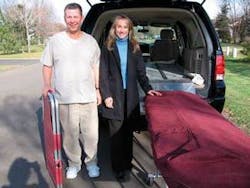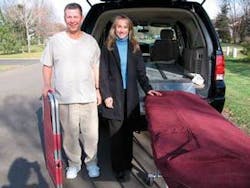From Mortician to Dental Hygienist
by Anneta Rehbein, RDH, and Ann-Marie DePalma, RDH, BS
Forensic dentistry is defined as the procedures done in the name of the law and in conjunction with law enforcement for the protection provided by the law and the prevention of illegal acts.1 Mortuary science deals with the continuum of life that death and losses are part of. Dying or grieving people have the right to support and validation, and to grieve in their own way.2 Dental hygiene is defined as the study of preventive oral health care, and the management of behaviors required to prevent oral disease and promote health.3
What do these definitions have in common? Anneta Rehbein, RDH, BS, is a practicing hygienist and licensed mortician. She is a part-time hygienist at Snelling Avenue Dental in St. Paul, Minn., and a full-time, on-call mortician licensed in Minnesota and Wisconsin for Rehbein Services, which provides removal and transportation of deceased people in those states. She is also a D-MERT (Disaster Mortuary Emergency Response Team) and DPMU (Disaster Portable Morgue Unit) volunteer.
Anneta became a mortician in 1996 after a friend introduced her to the profession. No one in her family had ever been interested in the profession, other than a distant relative who expressed an interest but never acted on it. After she was exposed to the mortuary profession, Anneta researched it and immediately loved it! For most of us, it’s hard to imagine loving death.
Everything about mortuary science intrigued Anneta. She completed her studies at the University of Minnesota, Twin Cities, and worked as a mortician for a year in the preparation room of a high-volume company. It was an excellent experience for her, but the timing wasn’t right. She needed something more.
She decided she wanted to remain in the medical field and discovered the profession of dental hygiene. After completing her hygiene degree, also at the University of Minnesota, she began practicing at Snelling Avenue Dental in St. Paul.
Anneta believes she is drawn to these professions because of the individual care that each affords patients and families. Each requires compassion, care, guidance, and most importantly, trust. She has found that for dental hygiene, sharing knowledge with patients for their entire well-being is very gratifying. For mortuary science, the professional, dignified, and respectful way that morticians treat the deceased and their families is most gratifying.
In May 2005, Anneta decided she needed to spend more time in the mortuary profession and less in hygiene. She started a body removal service of deceased individuals, offering the service to funeral homes and the medical examiner’s office on weekends only. After six months of this much-needed service, Rehbein Services began operating 24 hours a day, seven days a week. She currently employs six morticians and nine assistants.
In addition to her work with Rehbein Services and Snelling Avenue Dental, Anneta is a volunteer for D-MERT and DPMU. She was on-call for D-MERT for 9/11, but was never activated. She and her co-worker and fellow hygienist Al Case provide volunteer services through DPMU. This group is available to handle disasters or fatalities with an overwhelming number of deaths. Al and Anneta recently participated in DPMU group training exercises at Camp Ripley in Little Falls, Minn.
With numerous technological advances, the dental department of the DPMU often utilizes new devices such as a portable digital DEXIS radiographic unit. This technology has immensely improved the identification process. Anneta believes that dental hygienists play an important role in all of the DPMU experiences, whether ante or postmortem or in daily clinical practice. The importance of maintaining thorough and up-to-date radiographs and dental charting cannot be stressed enough. For more information on D-MERT or DPMU, contact Tim Koch, regional coordinator, MN Department of Health, Mortuary Science Section, 651-201-3848. The national contact for DPMU is PennCare, Shawn Bryant and Don Bloom, (800) 392-7233.
Anneta is a unique individual with the qualities important for both mortuary science and dental hygiene.
“Anneta is high energy personified,” said co-worker Case. “She’s an ambitious entrepreneur and one of the rare breed who can excel in two different and demanding professions. We’re lucky to have her at Snelling Avenue Dental.”
To contact Anneta, go to www.snellingavenuedental.com.
After spending more than 25 years in private practice, Ann-Marie C. DePalma, RDH, BS, FAADH is currently a faculty member at Mt. Ida College’s dental hygiene program. She is a Fellow in the American Academy of Dental Hygiene and is also pursuing a master’s degree in education in instructional design. Ann-Marie has written numerous articles and provides continuing education programs for dental hygienists and dental team members. She can be reached at [email protected].
References
1 Gathering forensic evidence. From the Podium, RDH Feb. 2005.
2 Mount Ida College, Web site, Funeral Service Department.
3 Darby M, Walsh M. Dental hygiene: theory and practice.

